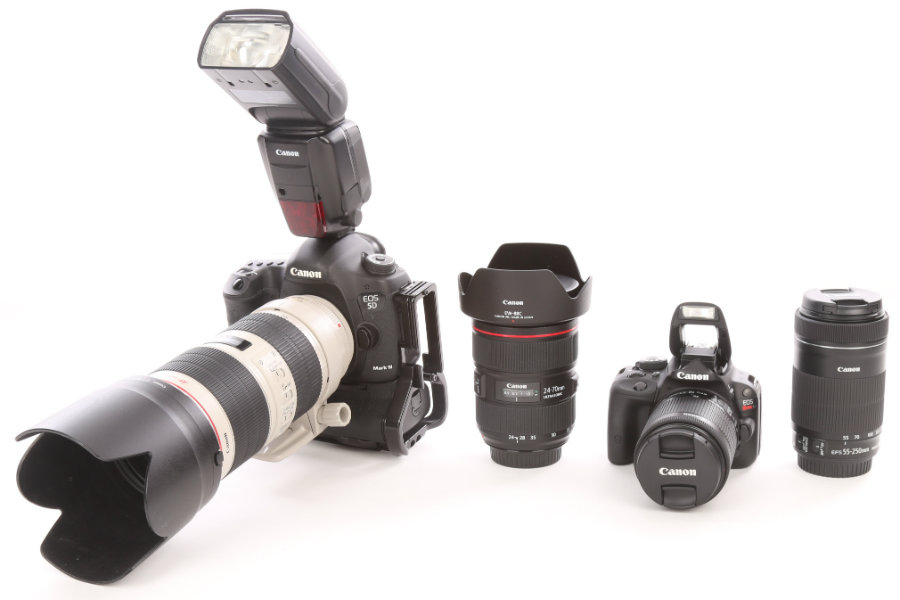Pro Camera Gear vs. Consumer Camera Gear: Does It Really Matter?

UNEDITED image shot by John – Left: Canon 5D Mark III (Professional) – Right: Canon SL1 (Consumer)
DANGER – WARNING – WATCH OUT! This post will get a few photographers down right ANGRY and spitting mad. How do I know? I’ve posted similar things before comparing pro to consumer and I’ve posted this image above before on Instagram with text on it that got some folks in an uproar. What I find amusing is that it’s NOT the photographers with the gear on the left whining and complaining, it’s the ones with the gear on the right saying they don’t need to gear on the left. That’s fine! I get it. Do the best you can with what you can afford, but whether you agree or not, there are differences that matter to full time professionals that make the investment difference worthwhile. If you feel that a $700 investment can yield the same results as a $7,000 investment, please, by all means, save your money and spend $700 not $7,000. Just do me a favor and don’t complain on social media about how much gear costs and call other photographers idiots for investing in gear catered to professionals.
I am still a firm believer that photographers should buy the gear that they can afford and that photographers should do the best they can with what they have to work with. However, the frustrating part to many established photographers is competing against photographers using the gear on the right above (consumer) at a much lower price point than they have to charge by using the gear on the left above (professional).
What are some of the differences in professional camera gear vs. consumer camera gear?
1) It’s clear to see in the image that size is obviously one difference.
2) Price (thousands vs. hundreds) is a key factor which has a lot to do with build quality.
3) Full Frame Sensor vs. Crop Sensor
There are numerous other differences, but the blog post would be very long if I tried to explain it all. Therefore, I’ll write briefly about the 3 areas above.
You may be wondering why size would really matter especially if you are a mirrorless camera owner. However, even if you shoot mirrorless, once you add a professional lens like the 70-200mm F2.8 on the left in the image, that mirrorless camera is not so small any longer. The reason the lenses are larger is because of all the glass that makes up the lens. The reason that professional DSLR bodies are larger than consumer bodies are things like DUAL card slots: The Canon 5D Mark III has a compact flash and an SD card slot vs. the Canon SL1 (and the majority of other consumer cameras) having just an SD card slot.
Professional gear can add up to several thousand dollars very quickly vs. consumer gear often only being a few hundred dollars. Here’s an example: 5D Mark III, Canon 600 EX-RT Speedlite, Canon 70-200mm L F2.8 and Canon 24-70mm L F2.8 has a current pricing as of this post of $5,800 and this same gear has been as high as around $7,500 at it’s peak when it all first hit the market. When compared to the Canon SL1 with a 18-55mm STM lens and a 55-250mm STM lens for $695, you can quickly see that even with current pricing that the professional gear is over $5,000 more. Yet, many people by simple consumer kits for under $1,000 and start a part-time photography business charging under $100 for a CD which confuses the average consumer. However, if there is no obvious quality difference, the photographer with the professional gear needs to step up his or her game because the part-time thorns will not be going away anytime soon. So stop complaining about it and do something productive about it.
Talk about full frame and crop sensor could fill up an e-book and goes far beyond this short paragraph. Yes, it’s true that most professionals shoot with full frame. However, there are exceptions to that statement and there are advantages to shooting with a crop sensor camera. For example, the Canon 7D Mark II is more conducive to action sports photography than the 5D Mark III. However, I am not an action sports photographer and the 5D Mark III works better for what I do. An advantage to using the 24-70mm on a full frame is that it’s a true 24mm-70mm lens which means that it is wider than using the same lens on a crop sensor which makes the 24mm multiplied by 1.6 (on Canon) to become a 38mm lens. However, the 70-200mm lens used on a crop sensor camera means that the 200mm multiplied by 1.6 (on Canon) become a 320mm lens which as you can see would likely be beneficial in numerous cases.
6 final thoughts on professional camera gear vs. consumer camera gear
1) Do the best you can with what you have to work with and can afford.
2) Don’t let gear envy hold you back on growing your photography business.
3) Even if you are using consumer gear, don’t be the cheapest photographer in town.
4) Don’t get hung up on full frame vs. crop sensor – DO LOTS OF RESEARCH
5) As your business grows, there will be certain clients that ask about your gear.
6) Invest in professional lenses first before buying a pro camera body and using a cheap lens.
David Williams
Latest posts by David Williams (see all)
- 5 Signs You’re Hiring the Wrong Photographer for Your Business - April 9, 2025
- How Will AI Change Professional Photography? - February 2, 2025
- Family Photographers vs. Commercial Photographers: Exploring the Differences in Approach, Purpose, and Technique - February 2, 2025
- Black and White Film Shot Of Our Golden Retriever: Trigger - February 2, 2022
- North Carolina Snow Images Shot In Franklin County - January 22, 2022




